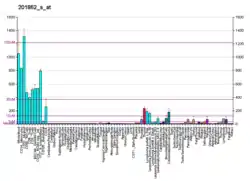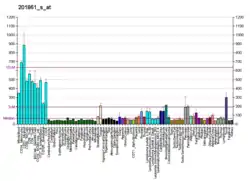LRRFIP1
Leucine-rich repeat flightless-interacting protein 1 is a protein that in humans is encoded by the LRRFIP1 gene.[5][6][7][8]
References
- GRCh38: Ensembl release 89: ENSG00000124831 - Ensembl, May 2017
- GRCm38: Ensembl release 89: ENSMUSG00000026305 - Ensembl, May 2017
- "Human PubMed Reference:". National Center for Biotechnology Information, U.S. National Library of Medicine.
- "Mouse PubMed Reference:". National Center for Biotechnology Information, U.S. National Library of Medicine.
- Reed AL, Yamazaki H, Kaufman JD, Rubinstein Y, Murphy B, Johnson AC (Sep 1998). "Molecular cloning and characterization of a transcription regulator with homology to GC-binding factor". J Biol Chem. 273 (34): 21594–602. doi:10.1074/jbc.273.34.21594. PMID 9705290.
- Liu YT, Yin HL (May 1998). "Identification of the binding partners for flightless I, A novel protein bridging the leucine-rich repeat and the gelsolin superfamilies". J Biol Chem. 273 (14): 7920–7. doi:10.1074/jbc.273.14.7920. PMID 9525888.
- Suriano AR, Sanford AN, Kim N, Oh M, Kennedy S, Henderson MJ, Dietzmann K, Sullivan KE (Oct 2005). "GCF2/LRRFIP1 represses tumor necrosis factor alpha expression". Mol Cell Biol. 25 (20): 9073–81. doi:10.1128/MCB.25.20.9073-9081.2005. PMC 1265793. PMID 16199883.
- "Entrez Gene: LRRFIP1 leucine rich repeat (in FLII) interacting protein 1".
- Fong KS, de Couet HG (Jun 1999). "Novel proteins interacting with the leucine-rich repeat domain of human flightless-I identified by the yeast two-hybrid system". Genomics. 58 (2): 146–57. doi:10.1006/geno.1999.5817. PMID 10366446.
Further reading
- Wilson SA, Brown EC, Kingsman AJ, Kingsman SM (1998). "TRIP: a novel double stranded RNA binding protein which interacts with the leucine rich repeat of flightless I". Nucleic Acids Res. 26 (15): 3460–7. doi:10.1093/nar/26.15.3460. PMC 147727. PMID 9671805.
- Khachigian LM, Santiago FS, Rafty LA, Chan OL, Delbridge GJ, Bobik A, Collins T, Johnson AC (1999). "GC factor 2 represses platelet-derived growth factor A-chain gene transcription and is itself induced by arterial injury". Circ. Res. 84 (11): 1258–67. doi:10.1161/01.res.84.11.1258. PMID 10364563.
- Fong KS, de Couet HG (1999). "Novel proteins interacting with the leucine-rich repeat domain of human flightless-I identified by the yeast two-hybrid system". Genomics. 58 (2): 146–57. doi:10.1006/geno.1999.5817. PMID 10366446.
- Rikiyama T, Curtis J, Oikawa M, Zimonjic DB, Popescu N, Murphy BA, Wilson MA, Johnson AC (2003). "GCF2: expression and molecular analysis of repression". Biochim. Biophys. Acta. 1629 (1–3): 15–25. doi:10.1016/s0167-4781(03)00156-8. PMID 14522076.
- Beausoleil SA, Jedrychowski M, Schwartz D, Elias JE, Villén J, Li J, Cohn MA, Cantley LC, Gygi SP (2004). "Large-scale characterization of HeLa cell nuclear phosphoproteins". Proc. Natl. Acad. Sci. U.S.A. 101 (33): 12130–5. doi:10.1073/pnas.0404720101. PMC 514446. PMID 15302935.
- Beausoleil SA, Villén J, Gerber SA, Rush J, Gygi SP (2006). "A probability-based approach for high-throughput protein phosphorylation analysis and site localization". Nat. Biotechnol. 24 (10): 1285–92. doi:10.1038/nbt1240. PMID 16964243. S2CID 14294292.
- Olsen JV, Blagoev B, Gnad F, Macek B, Kumar C, Mortensen P, Mann M (2006). "Global, in vivo, and site-specific phosphorylation dynamics in signaling networks". Cell. 127 (3): 635–48. doi:10.1016/j.cell.2006.09.026. PMID 17081983. S2CID 7827573.
This article is issued from Wikipedia. The text is licensed under Creative Commons - Attribution - Sharealike. Additional terms may apply for the media files.






